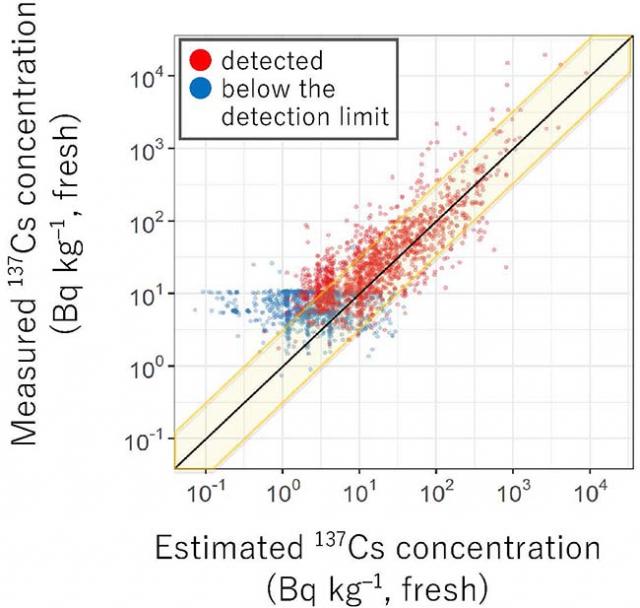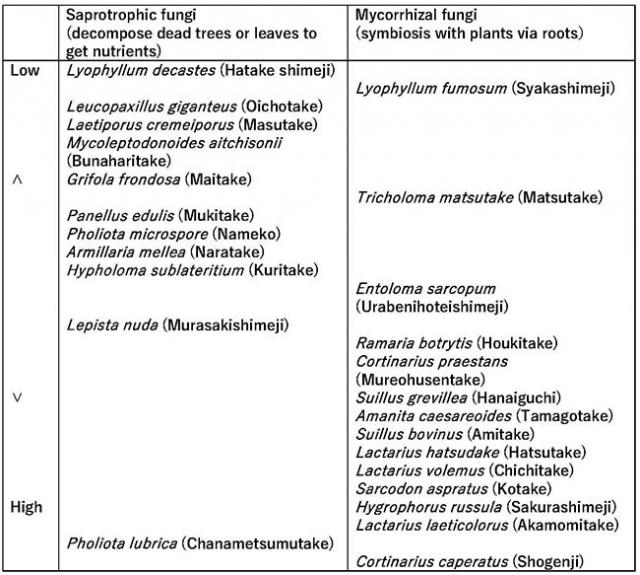Home > Research > Research Results > Research Results 2020 > The concentration of radioactive cesium in wild mushrooms varies by species.
Update:February 21, 2020
Main content starts here.
The concentration of radioactive cesium in wild mushrooms varies by species.
—Characteristics analysis of radioactive cesium contamination in wild mushrooms using large-scale open access datasets
| Article title |
Extensive analysis of radiocesium concentrations in wild mushrooms in eastern Japan affected by the Fukushima nuclear accident: Use of open accessible monitoring data |
|---|---|
| Author (affiliation) |
Masabumi Komatsu (a), Kazuya Nishina (b), Shoji Hashimoto (c, d) (a) Department of Mushroom Science and Forest Microbiology, FFPRI, Tsukuba, Ibaraki, Japan. (b) National Institute for Environmental Studies, Tsukuba, Ibaraki, Japan. (c) Department of Forest Soils, FFPRI, Tsukuba, Ibaraki, Japan. (d) The University of Tokyo, Bunkyo-ku, Tokyo, Japan. |
| Publication Journal |
Environmental Pollution 255(2), December 2019 DOI:10.1016/j.envpol.2019.113236( External link ) |
| Content introduction |
The accident at the Fukushima Daiichi Nuclear Power Station caused radioactive cesium to scatter over large areas, mainly in Fukushima Prefecture. Wild mushrooms with radioactive cesium exceeding the permissible food standard value of 100 Bq/kg have been found in many areas of eastern Japan owing to the high cesium absorption capacity of mushrooms. Hence, 110 cities, towns, and villages in 10 prefectures as of September 2019 are restricted from shipping wild mushrooms. A total of four to five thousand kinds of mushrooms have been reported with uncertain absorption concentration characteristics (indices indicating the ease of absorption of radioactive cesium in the environment). Therefore, unlike other agricultural products where shipping restrictions and releases are set on each item, wild mushrooms are subjected to a collective shipping restriction and the cancellation of these restrictions is conducted on a species basis. Meanwhile, after the Chernobyl nuclear accident, studies, conducted mainly in Europe, reported that the concentration of radioactive cesium in wild mushrooms exhibits certain particular tendencies for each species and genus. Under these circumstances, if we can clarify the concentration characteristics of radioactive cesium for each species of wild mushroom in Japan as well, we can revise the rules on shipping restrictions and releases. The concentration of radioactive cesium in wild mushrooms is assumed to depend not only on the species but also on the local growth environment and the contamination level of radioactive cesium. Therefore, for a further accurate report, it is important to show universal results independent of the area specificity. Hence, we focused on food radioactivity monitoring data. After the nuclear accident, analysis of radioactive cesium levels was conducted on various kinds of food, including mushrooms, in each municipality to confirm the safety of food and the results were published monthly on the Ministry of Health, Labor and Welfare website (https://www.mhlw.go.jp/english/topics/2011eq/index_food_radioactive.html). Based on the published monitoring data from 2011 to 2017, we obtained data from 3189 samples of wild mushrooms of 107 species from 265 municipalities in 14 prefectures. We also used the results of aircraft monitoring conducted by MEXT as data representing the extent of contamination in each region. The wild mushroom measurement data include information on the species, municipalities, and collection dates. The research group quantified these factors and developed a model to estimate the radioactive cesium concentration in the sample. As a result, the estimated values were close to the measured values for many mushrooms as shown in the Figure 1. It is possible to relatively estimate the actual radioactive cesium concentration of wild mushrooms based on the information on species, municipalities, and collection date. Table 1 shows representative species from which a large number of test samples (more than 20) were obtained, displayed in order from low levels to high, based on the cesium absorption levels obtained from the model. It is conceivable that the species with higher cesium absorption levels are likely to contain higher concentrations of radioactive cesium when compared in the same area. Generally, the group absorbing more cesium contains many types of mushrooms called mycorrhizal fungi that coexist with the roots of the trees, and the group absorbing less cesium contains more saprophytes, which are the mushroom types, that decompose fallen leaves and dead trees for nutrients. In this study, by analyzing data from a large number of species obtained over a wide area, it was possible to show that the concentration characteristics of radioactive cesium differed from species to species. Analyzing large-scale datasets, we have shown that the concentration of radioactive cesium in wild mushrooms varies depending on species. In the future, by conducting additional surveys and verifications, and improving the accuracy of the model to be estimated, it may be possible to use it to study the handling of shipping restrictions and cancellations.
Figure 1: Comparison of the estimated (horizontal axis) and measured (vertical axis) 137Cs concentration in wild mushrooms. The blue-circled "below the detection limit" data means that the concentration of the sample was lower than the detectable range of the measuring instrument, where the measured value indicates the detection limit of the measurement. When there is a point on the diagonal solid line, it means that the measured and estimated values are the same. The inclusion of points within the yellow band means that the ratio between the estimated and measured densities for such points is lower than 10 times.
Table 1: Cesium absorption dependence on species. Assuming the same environmental cesium concentration, species with lower cesium absorption capacity absorbed less radioactive cesium than species with higher capacity. |
Copyright © Forest Research and Management Organization. All rights reserved.


